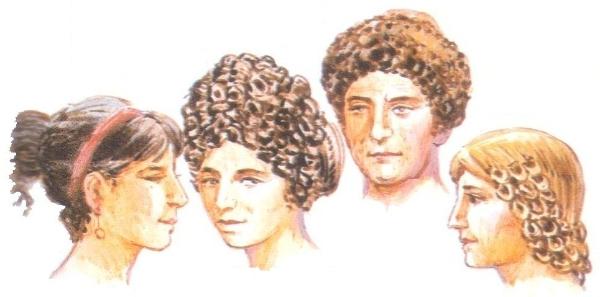STAGE II:
MIDDLE AGES:
The Middle Ages (7th – 15th century) Once the Romans withdrew from all the territories they had kept under their influence, they left behind a desolate panorama. In a town lacking even the most basic resources, extreme austerity triumphed over shaving and coquetry. Only in the Court and the small surroundings of the feudal lords was a standard of living maintained that allowed minimal aesthetic touches, which, yes, were usually limited to those collected in the manes of the ladies.
A pressing religion that forbade all kinds of frivolity also played a trick on those most presumptuous who could try to make up in a more original way than was strictly permitted.
Hair dyeing was no longer materially and morally possible. However, women had to wear their hair long and well tied, as the Church marked, which, at a time when having soap was considered a luxury, forced the imagination to sharpen to create all kinds of buns and braids. The only way to protect hair from dirt and lice was to cover it properly, so hoods, veils, caps and hats became widespread in winter and summer. The women tried to dress in the most flirtatious way possible without departing from the strictly indicated canons. The humblest of them wove braids of all kinds into their hair, which they generally never dropped, but curled over or around the head to form collected originals. His only resources for doing so were wooden combs and woollen threads. Often flowers were used as ornaments, as it was the only thing within their reach. The line in the middle was the most conventional and there used to be no time or desire to do anything that went beyond what was established. For the townspeople it was a dark time and too hard to think about physical beauty.
STAGE III:
RENAISSANCE:
The Renaissance (16th – 18th century) The cult of personal beauty was one of the values , the classical period that was recovered during the Renaissance. The emergence of a new economy and the interest and concern to return to a more civilized model of society restored the value of grooming and personal care. Fashion is created in the Court and hair styling specialists appear again who evolve in forms and ideas trying to recover the ancient headdresses of the Greek and Roman times.
Accessories proliferate and hairpieces appear, especially in the form of very elaborate braids and bows. Furthermore, interwoven hairnets, crowns and jewels extend not only across the Court, but among the burgeoning urban classes. Italy is once again the centre of European eyes and imposes its taste and its ideas of decoration and refined tendency on most of the western world of the time. In this way, the hairstyles of the Venetian houses and the fashion of dyeing the hair in reddish tones are expanded, for which mixtures of black sulphur, honey and alum were used, with which the hair was dabbed and later exposed to the sun to enhance the action of the formula. At this time the passion to change the natural colour of women’s hair was born, and ash blonde, gold thread and saffron colour were also popularized.
STAGE IV:
THE BAROQUE PERIOD: The seventeenth and eighteenth centuries were those of decorative wealth, exaggerations, the search for effect. But without a doubt if something characterizes the look of the time it is the wigs, by means of which the social classes were differentiated. His appearance was encouraged by Louis XIV of France, who wanted to hide his fledgling bald at any price, but they quickly spread throughout continental Europe and, later, Great Britain; despite the fact that at first they were seen as one of the eccentricities of the Court. In wigs and hairstyles the aesthetic tastes of the moment were reflected, so, although it may seem incredible, you can see monumentality, spectacular and ornate decorative richness, expressiveness, etc. In this way, unimaginable jewels, gauze, feathers, flowers, ribbons and elements were mixed with the hair, so that a wig could become the model of a castle or a ship. The more spectacular, the more prestige was gained socially. The curl during the Baroque, and the corkscrews, which definitely triumphed in the Rococo era, began, for the first time, to be created artificially, using cylindrical sticks that were then subjected to the heat of bakery ovens or even forges. The technique lasted and, centuries later, the first hot permanent were based on it. With the arrival of the French Revolution, in 1789, the ostentation of these centuries ended, and the simplicity and comfort to which the lower classes had never renounced, imposed themselves over sophisticated customs, which

